3.2
Copper Lane, London
3.2.1 1–6 Copper Lane, London
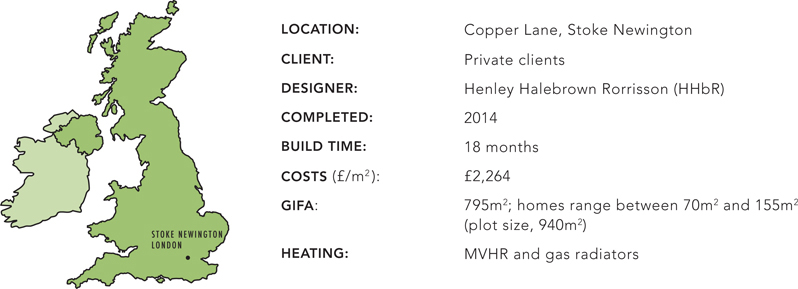
The Project
Six dwellings set around a central courtyard and a common hall. The homes are surrounded by communal gardens, all with varying light and aspects. The project began when two of the residents had the opportunity to buy a small backland plot from the local church. They rallied round to find others keen to purchase the plot with them, and so began London’s first co-housing scheme. To buy the land they formed a company with the six residents as directors.
This was HHbR’s first co-housing scheme, but their approach to creating a new typology for co-housing won them the project.

3.2.2 Site model, showing the 22 neighbours’ gardens.
Context
The urban landscape of Stoke Newington comprises Georgian terraces, some with shops on the ground floor, and leafy avenues. Set in a backland plot, surrounded by 22 neighbouring gardens and at the end of a narrow lane off Springdale Road, the site came with a set of significant challenges.
Benefits of Co-Housing
1–6 Copper Lane is not as ‘communal’ as other co-housing schemes, and the limitations of a small scheme are apparent. For example, there are no regular communal meals as it would be difficult to organise them with only six participants, with different schedules and on such a small site. They considered having common spare rooms but there wasn’t enough space, although an 18th birthday party sleepover was held in the common hall. The common hall and laundry are well used. There are often parties to which everyone is invited, and residents offer their own homes for visitors to stay in.
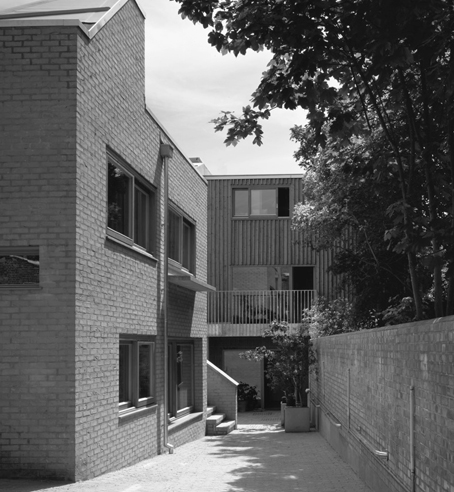
3.2.3 Entrance down a narrow, brick-paved lane.
The Design Approach by HHbR
HHbR felt that co-housing should have a typology, and this approach helped them to win over the future residents of Copper Lane. They did some cartoon diagrams looking at different types of communal buildings: a villa, a cluster, a monastery, and all the houses in a great big ring around the site.
HHbR looked at all the parameters of the site and tried to be as fair as they could about distributing light and views. A house on the north side was moved over to allow it to have a south-facing courtyard. The house in the north-east corner had a south-east terrace. They were constantly looking at ways of compensating and trying to get them not equal, but different in an equal way.
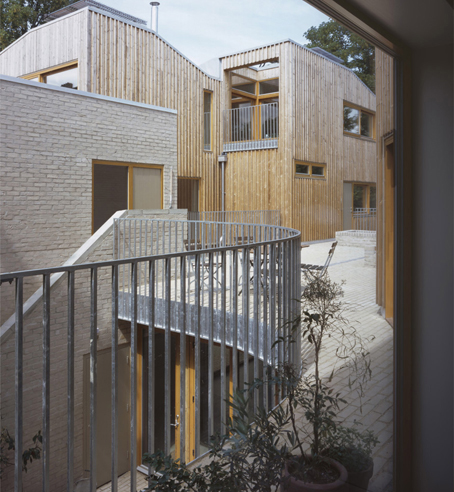
3.2.4 The dwellings have different orientations, to make the most of the site.
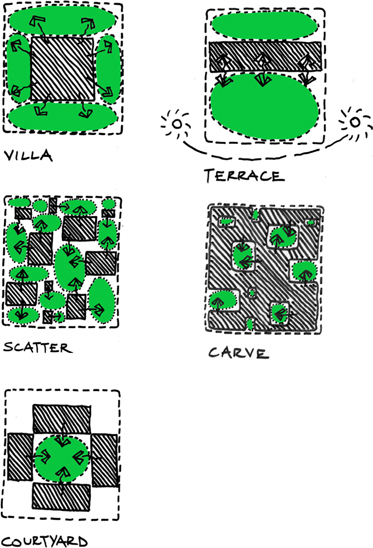
3.2.5 HHbR early massing cartoon studies.
The layout deliberately encourages communality without actually forcing it. Each house has two front doors, one into the communal hall or garden space and one more private one, so that you don’t always have to speak with other people. HHbR tried to achieve a balance of privacy and communality. The homes were sunk 1.2m into the ground, to keep their profile low and to relate to the back gardens of the neighbouring Victorian terraces. HHbR spent a long time negotiating an acceptable height with the planners. They pushed the main dwellings away from the neighbours’ gardens, which had the added benefit of bringing more light into the site.

3.2.7 Section showing communal hall with terrace above.

3.2.6 Lower-ground-floor plan, with doors from the dwellings leading directly to the communal hall and laundry.
Working with domestic clients is an intimate process, and with six it was always going to be a challenge. Sometimes HHbR felt they were seen as being inflexible, but they needed to make sure that the project stayed on track; there were so many opportunities for it to fragment. The group was strong, but when it is their own money and the pressure is on, self-interest comes naturally to the fore. It was quite tough for people to compromise.
The design intention was to create a common thread of materiality – the stair being a piece of furniture, the same windows, same kitchen tap, etc – to reduce cost and complication on site. The variations were then dependent on site position. However, HHbR came to realise that a project like this is a one-off opportunity for people, and if they really want a particular toilet then in the end that is the client’s choice.
Resident Feedback
INTERVIEWEE DETAILS: two of the founding residents and the author took a tour of the site
Comfort
The quality of light is very good and the heating bills are low. The MVHR system works, but in some houses the unit is hard to access. The residents don’t believe the MVHR was properly balanced, as one of them has made some ‘tweaks’ that have improved things.
Appropriateness
The external appearance is pleasing and the material quality is very high. This kind of housing is entirely appropriate for London, where tight, backland plots may be the only option in some areas to increase density and provide more housing. It is quite difficult to achieve a garden in the capital, but all the residents have the benefit of shared communal terraces and gardens surrounding the homes.
Sustainability
The residents I interviewed were very keen on sustainability, keeping energy bills low, Passivhaus and the Steiner School philosophy. They greatly appreciate the garden space, a real bonus in London. On Saturdays, they have gardening days when anyone who is around can help. People who are interested in co-housing can also volunteer on these days. They ran out of money for landscaping, so are doing this themselves bit by bit.

3.2.8 Communal terrace.
Improvement
Finishes were generally very high quality - the Douglas fir stairs, the rooflight over the common hall, the floor finish - however the residents interviewed noted that some aspects were not finished as hoped, unfortunately the architect’s recommendations were not always seen through. The development has also pleased the neighbours, even those who were initially most against it. It is nice for the Copper Lane residents, who didn’t want to make any enemies, to hear them compliment the scheme now it is finished.
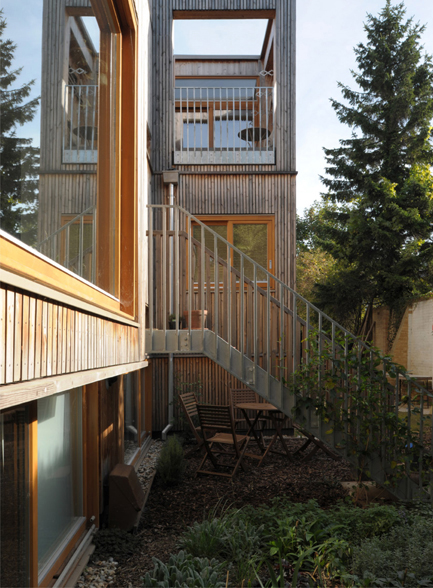
3.2.9 Communal gardens.
